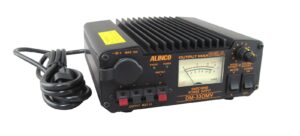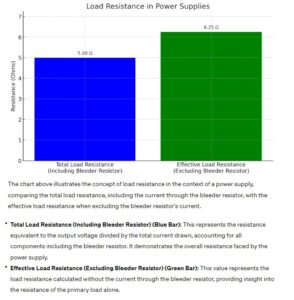



Start Here
Regulated Power Supplies – Transmitters, Modulation, and Processing
This chapter dives into the intricacies of regulated power supplies, a cornerstone in the realms of transmitters, modulation, and signal processing. It begins by examining the series-regulated power supply, focusing on the relationship between power dissipation in the pass transistor and the load current and voltage differential. This sets the stage for a broader exploration of the characteristics and performance of regulated power supplies, including the distinction between static and dynamic regulation and the pivotal role of components like fuses and capacitors. The discussion also covers the connection of electrolytic filter capacitors to voltage regulators and the vital function of diodes in protecting against reverse voltages. Understanding these elements is crucial for anyone involved in designing or operating electronic equipment, particularly in areas requiring precise voltage control such as communication systems and complex signal processing.
Be sure to login to your hamshack.ca account to track your progress by clicking the [Mark Complete] Button at the bottom of each lesson. You can contact VE7DXE to sign-up for the new Basic Amateur course.
Power Dissipation in Series-Regulated Power Supplies (A-004-004-001)
Understanding Power Dissipation in Series Regulators: Question A-004-004-001 examines the power dissipation in the pass transistor of a series-regulated power supply. The correct answer, A) directly proportional to the load current and the input/output voltage differential, highlights the relationship between power dissipation, load current, and voltage differential. In a series regulator, the power dissipated by the pass transistor is a product of the voltage drop across it and the current it carries. This relationship is crucial for thermal management, as excessive power dissipation can lead to overheating. Understanding this aspect is vital for designing efficient power supplies and selecting appropriate heat sinks to ensure the reliability and longevity of the system.
Parallels:
- Car Engine Workload: Similar to how a car engine’s workload increases with speed and load, the power dissipation in a pass transistor rises with higher load current and voltage differential.
- Water Flow Through a Pipe: The power dissipation in the pass transistor can be likened to water flow through a pipe, where the pressure drop (voltage differential) and water flow (current) determine the energy loss.
Question Summary and Key Takeaways:
- Direct Proportionality: Power dissipation depends on load current and voltage differential.
- Crucial for Thermal Management: Understanding this relationship is key to preventing overheating.
- Important in Power Supply Design: Guides the choice of components and cooling mechanisms.
- Relates to System Efficiency: Affects overall efficiency and performance of the power supply.
- Necessitates Heat Dissipation Solutions: Importance of appropriate heat sinks or cooling methods.
Output Quality in Regulated Power Supplies (A-004-004-002)
Where Output Quality is Optimal: Question A-004-004-002 explores where the output is cleanest and regulation is best in a regulated power supply. The answer, D) at the point where the sampling network or error amplifier is connected, indicates that the highest quality of output and regulation occurs at this feedback point. The error amplifier adjusts the regulation based on the feedback from this location, ensuring that the output voltage remains stable and clean despite input or load variations. This aspect is crucial in applications where precise voltage regulation is necessary, such as in sensitive electronic equipment or communication devices.
Parallels:
- Control Center in a Factory: The error amplifier’s role is akin to a control center in a factory, where adjustments are made based on feedback to ensure optimal production quality.
- Thermostat in a Heating System: Similar to a thermostat that regulates temperature based on feedback from its location, ensuring consistent environmental conditions.
Question Summary and Key Takeaways:
- Feedback Point Critical for Quality: The best output quality is at the feedback point.
- Role of Error Amplifier: Adjusts regulation to maintain stable and clean output.
- Essential for Precision-Dependent Applications: Vital in electronic systems requiring exact voltage levels.
- Impact on Power Supply Performance: Influences the reliability and accuracy of the supply.
- Key in Designing Regulated Supplies: Understanding this aspect is crucial for effective circuit design.
Load Resistance in Power Supplies (A-004-004-003)
Concept of Load Resistance: Question A-004-004-003 addresses the definition of load resistance in the context of a power supply. The correct answer, D) load, refers to the resistance equivalent to the output voltage divided by the total current drawn, including the current through the bleeder resistor. Load resistance is a crucial factor in designing and evaluating power supplies, as it represents the total resistance faced by the power supply when delivering power to the load and any additional components like the bleeder resistor. Understanding load resistance is key to ensuring that the power supply can efficiently and safely provide the necessary power to the connected devices.
Parallels:
- Water Flow Through Pipes: Like the resistance faced by water flowing through a pipe system, load resistance represents the total ‘opposition’ the power supply experiences when supplying power.
- Traffic Flow on Roads: Similar to how traffic flow is influenced by road conditions, the load resistance affects how the power supply ‘delivers’ electricity to the connected devices.
Question Summary and Key Takeaways:
- Definition of Load Resistance: Calculated as output voltage divided by total current draw.
- Incorporates Bleeder Resistor Current: Includes current through additional components.
- Impact on Power Supply Design: Essential for designing effective power supply systems.
- Safety and Efficiency Considerations: Ensures the power supply can handle the load safely.
- Fundamental in Circuit Analysis: Critical for understanding and analyzing power supply performance.
Static Regulation in Power Supplies (A-004-004-004)
Understanding Static Regulation: In Question A-004-004-004, the focus is on the term describing the regulation of long-term changes in load resistance. The correct answer, B) static regulation, defines a power supply’s ability to maintain a stable output voltage over time despite gradual changes in the load. Static regulation is an important characteristic of power supplies, especially in applications where the load may vary slowly but predictably. It indicates the power supply’s effectiveness in adapting to these changes to ensure consistent performance, essential for the reliability and longevity of both the power supply and the connected equipment.
Parallels:
- Temperature Control in a Building: Like a heating system that maintains a stable temperature despite gradual changes in outside weather, static regulation maintains voltage stability over time.
- Cruise Control in Vehicles: Similar to how cruise control adjusts to maintain a constant speed despite gradual inclines or declines, static regulation adapts to long-term load changes.
Question Summary and Key Takeaways:
- Regulation Over Time: Static regulation deals with long-term load changes.
- Indicates Stability: Shows how well the power supply adapts to gradual variations.
- Essential for Consistent Performance: Critical in applications with slowly varying loads.
- Reliability and Longevity: Affects the overall dependability of the power supply and connected devices.
- Key Aspect in Power Supply Design: Important for designing power supplies for specific applications.
Dynamic Regulation in Power Supplies (A-004-004-005)
Responding to Rapid Load Changes: Question A-004-004-005 asks about the term that describes the regulation of short-term changes in load resistance. The correct answer is C) dynamic regulation. This refers to the power supply’s capacity to quickly and effectively respond to rapid, transient changes in the load. Dynamic regulation is crucial in scenarios where the load can fluctuate suddenly, such as in digital circuits or communication systems. The ability of a power supply to maintain stable voltage under these conditions is vital for preventing malfunctions and ensuring the smooth operation of the connected equipment.
Parallels:
- Reflexes in Sports: Like an athlete’s quick reflexes to sudden movements, dynamic regulation allows a power supply to rapidly adjust to load changes.
- Emergency Braking in Vehicles: Similar to a car’s braking system responding instantly to avoid a collision, dynamic regulation reacts swiftly to maintain voltage stability.
Question Summary and Key Takeaways:
- Quick Response to Load Fluctuations: Dynamic regulation addresses short-term changes.
- Crucial in Transient Conditions: Essential for systems with sudden load variations.
- Stability During Fluctuations: Prevents voltage instability during rapid changes.
- Importance in Sensitive Equipment: Key to the proper functioning of digital and communication systems.
- Design Consideration in Power Supplies: Critical for choosing or designing power supplies for dynamic environments.
Enhancing Dynamic Regulation with Output Capacitors (A-004-004-006)
Role of Output Capacitors in Dynamic Regulation: Question A-004-004-006 explores how to improve the dynamic regulation of a power supply. The correct answer, A) the output capacitor, highlights the significance of increasing the value of the output capacitor. A larger output capacitor enhances the power supply’s ability to maintain a stable voltage during rapid changes in load or input voltage. This is due to its increased energy storage capacity and better filtering capabilities, which help smooth out voltage fluctuations, thereby enhancing the power supply’s dynamic response to transient conditions.
Parallels:
- Shock Absorbers in Vehicles: Like shock absorbers that smooth out bumps for a steady ride, a larger output capacitor stabilizes voltage fluctuations for smoother power supply operation.
- Water Reservoir in Irrigation: Comparable to a larger water reservoir that provides a steady water supply during variable demand, an increased output capacitor ensures consistent voltage during load changes.
Question Summary and Key Takeaways:
- Stabilizing Voltage Fluctuations: A larger output capacitor helps maintain steady voltage.
- Enhanced Energy Storage: Increases the power supply’s capacity to handle transient changes.
- Improved Filtering: Contributes to smoother voltage output under dynamic conditions.
- Crucial for High-Performance Systems: Essential in systems requiring quick response to load changes.
- Design Strategy for Reliability: Important consideration in power supply design for dynamic applications.
Dynamic Regulation in Power Supply Filters (A-004-004-007)
Improving Dynamic Regulation with Output Capacitance: Question A-004-004-007 addresses how dynamic regulation can be enhanced in power supply filters, particularly for transmitters like SSB or CW. The answer, C) the output capacitance is increased, indicates that a higher output capacitance in the filter can lead to better dynamic regulation. This is because a larger capacitor can store more energy and provide better filtering, which is especially crucial in maintaining a stable output voltage under varying load conditions in transmission. The increased capacitance acts as a buffer against quick changes in power demand, ensuring that the transmitter operates smoothly and efficiently.
Parallels:
- Water Tank in a Plumbing System: Just as a larger water tank can provide a more consistent water supply during demand fluctuations, a larger output capacitor maintains voltage stability under load variations.
- Battery Capacity in Electronics: Similar to how a device with a larger battery handles power demands more effectively, increased output capacitance in a power supply ensures steadier voltage delivery.
Question Summary and Key Takeaways:
- Larger Capacitance for Stability: Enhances the ability to maintain consistent voltage.
- Energy Storage and Filtering: Key to handling variations in power demand.
- Crucial for Transmission Systems: Especially important in SSB or CW transmitters.
- Buffer Against Load Changes: Acts as a safeguard for smooth operation.
- Design Consideration in Power Supplies: Vital in choosing components for transmission-related applications.
Bridge Rectifiers in Regulated Power Supplies (A-004-004-008)
Function of Bridge Rectifiers: In Question A-004-004-008, the role of four diodes connected in a bridge configuration in a regulated power supply is explored. The correct answer, C) a rectifier, points to their function as a bridge rectifier. This configuration allows for efficient full-wave rectification, converting AC from the transformer into DC. The bridge rectifier is essential in many power supplies, providing a more consistent and higher voltage output compared to half-wave rectification. Its effectiveness in utilizing the entire AC cycle makes it a crucial component for stable and reliable power supply systems.
Parallels:
- Full Utilization of Water Cycle: The bridge rectifier’s use of the full AC cycle is akin to a system that efficiently uses both rain and groundwater, ensuring maximum resource utilization.
- All-Wheel Drive in Vehicles: Comparable to how an all-wheel-drive system uses all four wheels for better traction, the bridge rectifier uses all four diodes for more efficient current conversion.
Question Summary and Key Takeaways:
- Full-Wave Rectification: Utilizes both halves of the AC cycle for DC conversion.
- Efficient and Consistent Output: Offers more stable voltage compared to half-wave rectifiers.
- Key Component in Power Supplies: Essential for reliable power conversion.
- Improves Voltage Output: Ensures higher and more uniform voltage delivery.
- Widely Used in Electronic Systems: A fundamental part of many regulated power supplies.
Conductivity in Regulated Power Supplies (A-004-004-009)
Conductivity of Fuses in Power Supplies: Question A-004-004-009 asks about components in a regulated power supply that conduct AC before the transformer and DC before the output. The answer, B) fuses, highlights the role of fuses as safety devices that can conduct both AC and DC. Fuses are designed to protect the power supply and connected equipment by breaking the circuit in overcurrent conditions, regardless of whether the current is AC or DC. This makes them an essential component for ensuring the safety and integrity of power supply systems.
Parallels:
- Circuit Breaker in Home Wiring: Like a circuit breaker that interrupts excessive current in household wiring, fuses in power supplies prevent damage from overcurrent by conducting both AC and DC.
- Safety Valve in Pressure Systems: Similar to a safety valve releasing pressure to prevent system damage, fuses conduct current to protect against electrical overloads.
Question Summary and Key Takeaways:
- Fuses as Safety Devices: Conduct both AC and DC to protect against overcurrent.
- Essential for Power Supply Safety: Integral in preventing damage to the system.
- Versatile Conductivity: Effective in both AC and DC circuits.
- Prevents Electrical Overloads: Breaks the circuit under excessive current conditions.
- Fundamental in Circuit Protection: A basic yet crucial component in regulated power supplies.
Voltage Regulator Connection in Power Supplies (A-004-004-010)
Connection of Electrolytic Filter Capacitor: Question A-004-004-010 explores where the output of the electrolytic filter capacitor in a regulated power supply is connected. The correct answer, A) voltage regulator, signifies the capacitor’s role in smoothing the rectified DC before it reaches the voltage regulator. The voltage regulator then maintains a stable output voltage, adjusting for any remaining fluctuations. This setup ensures that the regulated power supply provides a consistent and reliable DC output, which is essential for the smooth operation of electronic devices.
Parallels:
- Pre-Processing in Manufacturing: Like initial processing stages that prepare materials for final production, the electrolytic filter capacitor prepares the voltage for final regulation.
- Pre-Filter in a Water Purification System: Similar to a pre-filter removing major contaminants before fine purification, the capacitor smooths voltage before final regulation.
Question Summary and Key Takeaways:
- Smoothing Rectified DC: Filter capacitor’s primary role before voltage regulation.
- Preparation for Voltage Regulation: Ensures cleaner voltage input to the regulator.
- Essential for Stable Output: Contributes to consistent power supply performance.
- Integration in Power Supply Design: A critical step in the power supply circuit.
- Reliability in Electronic Systems: Ensures the dependable operation of connected devices.
Reverse Voltage Protection in Power Supplies (A-004-004-011)
Diode Protection Against Reverse Voltages: In Question A-004-004-011, the use of a diode connected across the input and output terminals of a regulator in a power supply is discussed. The correct answer, A) protect the regulator from reverse voltages, highlights the diode’s role as a protective component. This diode safeguards the regulator from potential damage due to reverse voltage spikes or polarity reversal, a critical feature for ensuring the longevity and reliability of the power supply. It acts as a preventive measure against accidental damage, especially in scenarios where voltage sources might be incorrectly connected or where transient spikes occur.
Parallels:
- One-Way Valve in Plumbing: Like a one-way valve preventing backflow in a piping system, the diode prevents reverse voltage from flowing back into the regulator.
- Surge Protector in Electrical Outlets: Similar to a surge protector blocking voltage spikes, the diode guards the regulator against reverse voltage damages.
Question Summary and Key Takeaways:
- Protection from Reverse Voltages: Diode serves as a safeguard for the regulator.
- Preventing Regulator Damage: Essential for protecting against polarity reversals or spikes.
- Enhances Power Supply Safety: Increases the reliability of the power supply.
- Critical in Circuit Design: An important component in power supply construction.
- Preventive Safety Measure: A simple yet effective way to enhance circuit longevity.
Insights into the Functionality of Regulated Power Supplies
Throughout this chapter, we have navigated the complexities of regulated power supplies, key to the efficient functioning of transmitters and signal processing units. We explored how power dissipation in series-regulated power supplies is influenced by load current and voltage differential, and the importance of maintaining clean and stable output through optimal regulation. The distinctions between static and dynamic regulation were highlighted, emphasizing their roles in adapting to long-term and short-term load changes, respectively. The chapter also shed light on the significance of output capacitors in enhancing dynamic regulation, the function of bridge rectifiers in full-wave rectification, and the protective role of diodes against reverse voltages. Additionally, we discussed the importance of fuses in conducting both AC and DC, ensuring safety in power supply systems. This comprehensive exploration not only enhances the understanding of regulated power supplies but also underscores their critical role in a wide array of electronic applications, from basic power distribution to advanced communication and signal processing technologies.
© Hamshack.ca. All lesson content, diagrams, and quizzes are proprietary and protected by copyright. Access is for personal use only and requires a valid course purchase where applicable. Copying, sharing, or redistributing any material is strictly prohibited. See the Hamshack.ca Terms of Use for full details.
